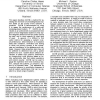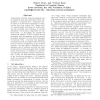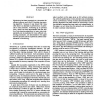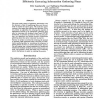IJCAI
1997
14 years 1 months ago
1997
A semi-structured information space consists of multiple collections of textual documents containing fielded or tagged sections. The space can be highly heterogeneous, because eac...
IJCAI
1997
14 years 1 months ago
1997
Object identification—the task of deciding that two observed objects are in fact one and the same object—is a fundamental requirement for any situated agent that reasons about...
IJCAI
1997
14 years 1 months ago
1997
Psychological experiments on children's development of spatial knowledge suggest experience at self-locomotion with visual tracking as important factors. Yet, the mechanism u...
IJCAI
1997
14 years 1 months ago
1997
This paper describes QUEM, a method for assessing the skill level of a knowledge-based system based on the quality of the solutions it produces. QUEM is demonstrated by using it t...
IJCAI
1997
14 years 1 months ago
1997
Many of the challenges faced by the £eld of Computational Intelligence in building intelligent agents, involve determining mappings between numerous and varied sensor inputs and ...
IJCAI
1997
14 years 1 months ago
1997
The objective of this work is to interpret inductive results obtained by the unsupervised learning method OSHAM. We briefly introduce the learning process of OSHAM, that extracts ...
IJCAI
1997
14 years 1 months ago
1997
Propositional STRIPS planning problems can be viewed as finite state automata (FSAs) represented in a factored form. Automaton minimization is a well-known technique for reducing ...
IJCAI
1997
14 years 1 months ago
1997
As an alternative to planning, an approach to highlevel agent control based on concurrent program execution is considered. A formal definition in the situation calculus of such a ...
IJCAI
1997
14 years 1 months ago
1997
Windowing has been proposed as a procedure for efficient memory use in the ID3 decision tree learning algorithm. However, it was shown that it may often lead to a decrease in perf...
IJCAI
1997
14 years 1 months ago
1997
Themost costly aspect of gathering information over the Internet is that of transferring data over the networkto answer the user’s query. Wemaketwo contributions in this paperth...






